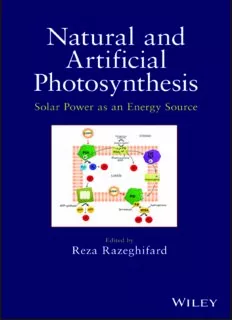
Natural and artificial photosynthesis : solar power as an energy source PDF
Preview Natural and artificial photosynthesis : solar power as an energy source
NATURAL AND ARTIFICIAL PHOTOSYNTHESIS NATURAL AND ARTIFICIAL PHOTOSYNTHESIS SOLAR POWER AS AN ENERGY SOURCE Editedby Reza Razeghifard Coverdesign:Wiley Coverillustration:(cid:2)C MatthewTimmins Copyright(cid:2)C 2013byJohnWiley&Sons,Inc.Allrightsreserved. PublishedbyJohnWiley&Sons,Inc.,Hoboken,NewJersey. PublishedsimultaneouslyinCanada. Nopartofthispublicationmaybereproduced,storedinaretrievalsystem,ortransmittedinanyformor byanymeans,electronic,mechanical,photocopying,recording,scanning,orotherwise,exceptas permittedunderSection107or108ofthe1976UnitedStatesCopyrightAct,withouteithertheprior writtenpermissionofthePublisher,orauthorizationthroughpaymentoftheappropriateper-copyfeeto theCopyrightClearanceCenter,Inc.,222RosewoodDrive,Danvers,MA01923,(978)750-8400, fax(978)750-4470,oronthewebatwww.copyright.com.RequeststothePublisherforpermission shouldbeaddressedtothePermissionsDepartment,JohnWiley&Sons,Inc.,111RiverStreet,Hoboken, NJ07030,(201)748-6011,fax(201)748-6008,oronlineathttp://www.wiley.com/go/permission. LimitofLiability/DisclaimerofWarranty:Whilethepublisherandauthorhaveusedtheirbesteffortsin preparingthisbook,theymakenorepresentationsorwarrantieswithrespecttotheaccuracyor completenessofthecontentsofthisbookandspecificallydisclaimanyimpliedwarrantiesof merchantabilityorfitnessforaparticularpurpose.Nowarrantymaybecreatedorextendedbysales representativesorwrittensalesmaterials.Theadviceandstrategiescontainedhereinmaynotbesuitable foryoursituation.Youshouldconsultwithaprofessionalwhereappropriate.Neitherthepublishernor authorshallbeliableforanylossofprofitoranyothercommercialdamages,includingbutnotlimitedto special,incidental,consequential,orotherdamages. Forgeneralinformationonourotherproductsandservicesorfortechnicalsupport,pleasecontactour CustomerCareDepartmentwithintheUnitedStatesat(800)762-2974,outsidetheUnitedStatesat (317)572-3993orfax(317)572-4002. Wileyalsopublishesitsbooksinavarietyofelectronicformats.Somecontentthatappearsinprintmay notbeavailableinelectronicformats.FormoreinformationaboutWileyproducts,visitourwebsiteat www.wiley.com. LibraryofCongressCataloging-in-PublicationData: Razeghifard,Reza,1964-editorofcompilation. Naturalandartificialphotosynthesis:solarpowerasanenergysource/editor,RezaRazeghifard. pages cm Includesbibliographicalreferencesandindex. ISBN978-1-118-16006-0(cloth) 1.Renewableenergysources. 2.Photosynthesis–Industrialapplications. I.Title. TJ811.8.N372013 621.042–dc23 2013002851 PrintedintheUnitedStatesofAmerica 10 9 8 7 6 5 4 3 2 1 CONTENTS Preface xv Contributors xix Acronyms xxiii 1 PhysicsOverviewofSolarEnergy 1 DiegoCastano 1.1 Introduction 1 1.2 TheSun 2 1.3 Light 3 1.4 Thermodynamics 6 1.5 Photovoltaics 9 1.6 Photosynthesis 11 References 12 2 OxygenicPhotosynthesis 13 DmitriyShevela,LarsOlofBjo¨rn,andGovindjee 2.1 Introduction 13 2.1.1 ImportanceofPhotosynthesis:WhyStudyPhotosynthesis? 13 2.1.2 OxygenicVersusAnoxygenicPhotosynthesis 14 2.1.3 WhatCanWeLearnfromNaturalPhotosynthesisto AchieveArtificialPhotosynthesis? 14 2.1.4 AtomicLevelStructuresofPhotosyntheticSystems 15 2.1.5 ScopeoftheChapter 16 2.2 PathofEnergy:FromPhotonstoChargeSeparation 16 2.2.1 Overview:HarvestingSunlightforRedoxChemistry 16 2.2.2 LightabsorptionandLight-HarvestingAntennas 16 2.2.3 ExcitationEnergyTransfer:CoherentVersusIncoherentor WavelikeVersusHopping 20 2.2.4 ConcludingRemarksandFuturePerspectivesforArtificial Photosynthesis 22 v vi CONTENTS 2.3 ElectronTransferPathways 22 2.3.1 OverviewofthePrimaryPhotochemistryandtheElectron TransferChain 22 2.3.2 ComponentsAssociatedwithP680andP700andtheEntry intotheElectronTransferChain 24 2.3.3 PhotosystemII:FunctionandElectronTransferPathway 26 2.3.4 PhotosystemI:FunctionandtheElectronTransfer Pathways 28 2.3.5 IntersystemElectronTransfer 29 2.3.6 WaterasaSourceofElectronsforthePhotosynthetic ElectronTransferChain 30 2.3.7 CantheRateLimitationofO ProductionbyPhotosystem 2 IIBeImprovedinFutureArtificialWater-Splitting Systems? 30 2.4 Photophosphorylation 30 2.4.1 Overview 30 2.4.2 MechanismofATPSynthesis 31 2.4.3 ConcludingRemarks 33 2.5 CarbonDioxidetoOrganicCompounds 33 2.5.1 OverviewofCarbonDioxideAssimilationSystemsin OxygenicOrganisms 33 2.5.2 C3PathwayVersusC4Pathway 33 2.5.3 C3versusC4PlantsDuringGlacial/InterglacialPeriods 35 2.5.4 ConcludingRemarks:CantheNaturalAssimilation PathwaysBeImprovedtoHelpSolvetheEnergyCrisis? 36 2.6 EvolutionofOxygenicPhotosynthesis 37 2.6.1 Overview 37 2.6.2 TwoPhotosystemsforOxygenicPhotosynthesis 38 2.6.3 EvolutionaryAcclimationtoDecreasingCO Availability 40 2 2.7 SomeInterestingQuestionsaboutWholePlants 42 2.7.1 Overview 42 2.7.2 WhyAreThereGranainLandPlantsbutNotinAlgae? 43 2.7.3 WhyAreLeavesDarkerontheUpperSidethanonthe LowerSide? 44 2.7.4 HowMuchDoDifferentLayersintheLeafContributeto Photosynthesis? 45 2.7.5 HowDoesPhotosynthesisInteractwith Climate-Atmosphere? 46 2.7.6 IsTherePhotosynthesisWithoutCO Assimilation 2 (N FixationinCyanobacteria,Light-DependentN − 2 3 AssimilationinLandPlants)? 47 2.7.7 HowCanAnimalsCarryOutPhotosynthesis? 47 CONTENTS vii 2.8 PerspectivesfortheFuture 48 2.9 Summary 48 Acknowledgments 49 References 49 3 ApparatusandMechanismofPhotosyntheticWaterSplittingas Nature’sBlueprintforEfficientSolarEnergyExploitation 65 GernotRenger 3.1 Introduction 65 3.2 OverallReactionPatternofPhotosynthesisandRespiration 67 3.3 BioenergeticLimitofSolarEnergyExploitation:WaterSplitting 68 3.4 Humankind’sDreamofUsingWaterandSolarRadiationas “CleanFuel” 69 3.5 Nature’sBlueprintofLight-InducedWaterSplitting 71 3.6 TypesofApproachesinPerformingLight-DrivenH andO 2 2 FormationfromWater 71 3.6.1 UseofPhotosyntheticOrganisms 72 3.6.2 HybridSystems 72 3.6.3 SyntheticSystems 74 3.6.4 OxidativeWaterSplittingintoO and4H+ 75 2 3.6.5 SyntheticWOCs 76 3.6.6 Light-InducedWaterSplittinginPhotosystemII 77 3.7 Light-Induced“Stable”ChargeSeparation 78 3.8 EnergeticsofLight-InducedChargeSeparation 80 3.9 OxidativeWaterSplitting:TheKokCycle 82 3.10 Y OxidationbyP680+• 83 Z 3.11 StructureandFunctionoftheWOC 86 3.11.1 StructureoftheCatalyticMn–CaClusterandits CoordinationSphere 87 3.11.2 ElectronicConfigurationandNuclearGeometryin theS StatesoftheCatalyticSite 90 i 3.11.3 KineticsofOxidativeWaterSplittingintheWOC 92 3.11.4 Substrate/ProductPathways 93 3.11.5 MechanismofOxidativeWaterSplitting 95 3.12 ConcludingRemarks 102 Acknowledgments 102 References 103 4 ArtificialPhotosynthesis 121 RezaRazeghifard 4.1 Introduction 121 4.2 OrganicPigmentAssembliesonElectrodes 122 viii CONTENTS 4.3 PhotosystemAssembliesonElectrodes 124 4.4 HydrogenProductionbyPhotosystemIHybridSystems 127 4.5 MimickingWaterOxidationwithManganeseComplexes 128 4.6 ProteinDesignforIntroducingManganeseChemistryinProteins 130 4.7 ProteinDesignandPhotoactiveProteinswithChlDerivatives 131 4.8 Conclusion 133 Acknowledgment 133 References 134 5 ArtificialPhotosynthesis:RutheniumComplexes 143 DimitriosG.Giarikos 5.1 Ruthenium(II) 143 5.2 LigandInfluenceonthePhotochemistryofRu(II) 145 5.3 ImportanceofPolypyridylLigandsandMetalIonforTuningof MLCTTransitions 149 5.4 ElectronTransferofRu(II)Complexes 150 5.5 Light-HarvestingComplexesUsingRu(II)Complexes 151 5.6 Ru(II)ArtificialPhotosystemModelsforPhotosystemII 157 5.7 Ru(II)ArtificialPhotosystemModelsforHydrogenase 161 5.8 Conclusion 166 References 166 6 CO SequestrationandHydrogenProductionUsingCyanobacteria 2 andGreenAlgae 173 KanhaiyaKumarandDebabrataDas 6.1 Introduction 173 6.2 Microbiology 174 6.3 BiochemistryofCO Fixation 176 2 6.3.1 CO AssimilationandConcentratingMechanismsinAlgae 176 2 6.3.2 Carbon-ConcentratingMechanisms(CCMs) 178 6.4 ParametersAffectingtheCO SequestrationProcess 180 2 6.4.1 SelectionofAlgalSpecies 180 6.4.2 EffectofFlueGasComponent 181 6.4.3 EffectofPhysiochemicalParameters 182 6.4.4 IssuesofProductInhibition 182 6.5 HydrogenProductionbyCyanobacteria 183 6.5.1 MechanismofHydrogenProduction 183 6.5.2 ModeofHydrogenProduction 191 6.5.3 HydrogenaseVersusNitrogenase-BasedHydrogen Production 192 6.5.4 FactorsAffectingHydrogenProductioninCyanobacteria 192 6.5.5 RecentAdvancesintheFieldofHydrogenProduction UsingCyanobacteria 193
